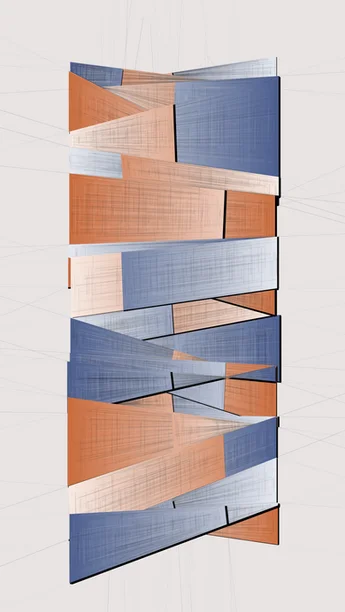
Jeff ippsketch, Bound, 2022
How did you first get into making art and in particular generative art?
As a mechanical engineer by training, I have strengths in coding, simulation, and problem solving. I’m self-taught in drawing and watercolor, but I’ve always found it difficult to advance on a technical level. Making art with a computer, by painting with pixels instead of pigments, has allowed me to lean into my strengths. Engineering simulations utilize random processes to produce sets of possible results and then visualizations are produced to understand and communicate their meaning. From that framework, it’s a natural jump to generative art, which involves using code and harnessing the power of randomness to create visual outputs. The engineering side of me also loves the precision and repeatability that sketching with code provides.
Which artist inspires you the most in your practice?
Sol LeWitt has been a huge influence for me. I really connect with his minimalist aesthetic, but most importantly, his Wall Drawings. At their core, Wall Drawings are the instructions, just like the code in generative art. In some sense, the instructions are the art, perhaps even more so than the art on the wall. This is not unlike generative art. The generative art pioneer Vera Molnar’s has also been a tremendous influence on me. She’s one of the first and best to embrace randomness as an essential element in her work.
Do you see the traditional art world and the NFT world connecting more and more in the future, or they will always be two different spaces?
As NFTs are used more and more to provide proof of ownership and uniqueness, not just for art but for any number of transactions, it seems inevitable that they’ll become more and more commonly used as a tool within the traditional art world. New technology always meets resistance and takes time to incorporate, but I’m excited to play a small part in helping connect the world of traditional art with NFTs.
Tell us more about your series Bound?
Bound started when I saw an interesting segmented and seemingly overlapped pattern on a wooden bench. This was my starting point and inspiration, but the work grew in a different direction once I started writing the code. That’s the thing I enjoy most about creating art with code. Once the coding starts and the images are generated by the computer, it can quickly move in a different direction, unforeseen by me from the start. For example, I added outlines to the structures of Bound, but a computer code mistake made them extend off the page. This immediately gave the work a tension, as if the shapes were getting pulled and stretched in multiple directions at once. Rather than fix the code, I embraced and finetuned the mistake. For me, the work very rarely finishes the way I viewed it in my mind from the start. Embracing these random occurrences and coding mistakes, and harnessing them, is what makes generative art so interesting and enjoyable.
Is there anything else you’d like to share to help people better understand your art?
My artist name (ippsketch) stands for i++ sketch. The increment operator (i++) is used in code to iterate a process forward, so it’s a reference to the computer behind the art, but it’s also a personal motto of sorts. Keep moving forward, keep iterating, keep adding skills, keep exploring new possibilities. That’s also why I chose ‘sketch’. Sketches aren’t finished – they’re improved and changed, modified or drawn again from scratch. So I think my work and I are constantly evolving. I’m just getting started. I’m excited to see what’s next.
